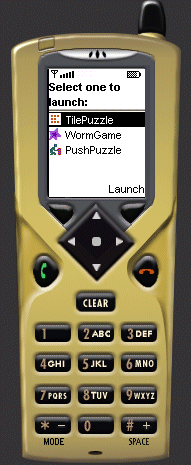J2me Wireless Toolkit 2 2 Windows Exe

Developing applications for Windows Mobile-based Smartphones. Retrieved January 05, 2006, from edgecenterpublic/hvelmk. J2ME Wireless Toolkit 2.2 — User's Guide. Retrieved April 21, 2006, from sun.com/j2me/docs/wtk2.2/docs/UserGuide.pdf Symbian Ltd. Java ME SDK 3.0 is the successor to the popular Java Wireless Toolkit 2.5.2 and Java Toolkit 1.0 for CDC. It integrates CLDC, CDC and Blu-ray Disc Java (BD-J) technology into one SDK. The Java ME SDK 3.0 is available for Windows XP and Vista 32-bit, and for the Mac OS.
| The Sun J2ME Wireless Toolkit supports the development of Java applications that run on devices such as cellular phones, two-way pagers, and palmtops. More information about the Sun J2ME Wireless Toolkit can be found at: http://java.sun.com/products/j2mewtoolkit/ Quick guides
|
CS6611 MOBILE APP LAB Manual
Anna University Regulation 2013 Computer Science & Engineering (CSE) CS6611 MOBILE APP LAB Manual for all experiments is provided below. Download link for IT 6th SEM CS6611 MOBILE APPLICATION DEVELOPMENT LAB Manual is listed down for students to make perfect utilization and score maximum marks with our study materials.
Battlefield 2 unlock all maps single player. Anna University Regulation 2013 Computer Science & Engineering (CSE) 6th SEM
CS6611 MOBILE APP LAB-MOBILE APPLICATION DEVELOPMENT LAB Manual
Objective:
In this lab, a student is expected to design, implement, document and present a mobile client/server system using standard Java and Java 2 Micro Edition (J2ME) platform. Specifically it is required to design and implement a system that consists mainly of a mobile client (MC) and a Proxy Server (PS). MC will be written in J2ME, MIDP 2.0, while PS will be written in standard Java. It is necessary to use a mobile phone emulator to develop and demonstrate the experiments.
It may be necessary to use other components or existing resources (servers) as needed. For instance a database local to PS or a web service available on the Internet that can be invoked by the PS.
Week – 1: Installation of Java Wireless Toolkit (J2ME)
1) If the Java Development Kit (JDK) is not theory only having the Java Runtime Environment (JRE) installed, install the latest JDK from http://java.sun.com/javase/downloads/index.jsp. Current stable release of Java is JDK 6 Update 7 but check the web page in case there are newer non-beta releases available.
2) Next, download the Java Wireless Toolkit (formerly called J2ME Wireless Toolkit) from: http://java.sun.com/products/sjwtoolkit/download.html.
3) Run the installer (for example, for Windows it is: sun_java_wireless_toolkit- 2_5_2- windows.exe). The installer checks whether a compatible Java environment has been preinstalled. If not, it is necessary to uninstall old versions of Java and perform Step 1 again. Once after successful installation of Java and the tool kit compile this program and run the following program in the toolkit.
Steps to run this program in toolkit:
Start -> All Programs -> Sun Java Tool Kit -> Wireless Tool Kit
Click New Project – Enter Project Name -> Enter Class Name ->
Click on Create Project. Choose appropriate API Selection and Configurations.
Place Java Source file in WTK2.1 / WTK2.2appsprojectnamesrc
Build the Project.
Run the Project.
import javax.microedition.lcdui.*;
import javax.microedition.midlet.*;
public class HelloWorld extends MIDlet{
private Form form; private Display display; public HelloWorld(){ super();
}
public void startApp(){
form = new Form(“Hello World”);
String msg = “Hello World!!!!!!!”; form.append(msg);
display = Display.getDisplay(this);
display.setCurrent(form); www.studentsfocus.com
}
public void pauseApp(){}
public void destroyApp(boolean unconditional){ notifyDestroyed(); } }
Week – 2
Working with J2ME Features:
Working with J2ME Features: Say, creating a Hello World program Experiment with the most basic features and mobile application interaction concepts (lists, text boxes, buttons, radio boxes, soft buttons, graphics, etc)
2.1 Create a program which creates to following kind of menu. * cut * copy * past * delete * select all * unselect all Program:
Source code:
import javax.microedition.midlet.*;
import javax.microedition.lcdui.*;
public class MenuCreation extends MIDlet implements CommandListener {
public ChoiceGroup ch;
public Form form;
public Display display;
public Command command;
public StringItem st;
public MenuCreation() {
display=Display.getDisplay(this);
ch=new ChoiceGroup(“Edit”,Choice.EXCLUSIVE);
ch.append(“cut”,null);
ch.append(“copy”,null);
ch.append(“paste”,null);
ch.append(“delete”,null);
ch.append(“select all”,null);
ch.append(“unselect all”,null);
ch.setSelectedIndex(1, true);
command=new Command(“Select list item”,Command.OK,1);
form=new Form(“”);
form.append(ch);
form.addCommand(command);
form.setCommandListener(this);
st=new StringItem(“”,””); }
public void startApp() { display.setCurrent(form);
}
public void pauseApp() { }
public void destroyApp(boolean unconditional) { }
public void commandAction(Command command,Displayable displayable) { if(commandcommand) { st.setText(“”); st.setText(“your selected option is “+ch.getString(ch.getSelectedIndex())); form.append(st); } } }
Output:
CS6611 Mobile App Lab Manual with all experiments – Download Here
If you require any other notes/study materials, you can comment in the below section.
Related Links
For CS6611 Mobile App Lab Syllabus – Click here
Search Terms
Anna University 6th SEM IT MOBILE APP LAB Manual
CS6611 MOBILE APPLICATION DEVELOPMENT LAB Manual free download
Anna University IT MOBILE APP LAB Manual Regulation 2013
CS6611 Manual, MOBILE APP LAB experiment wise Manual – IT 6th Semester
- среда 29 апреля
- 45